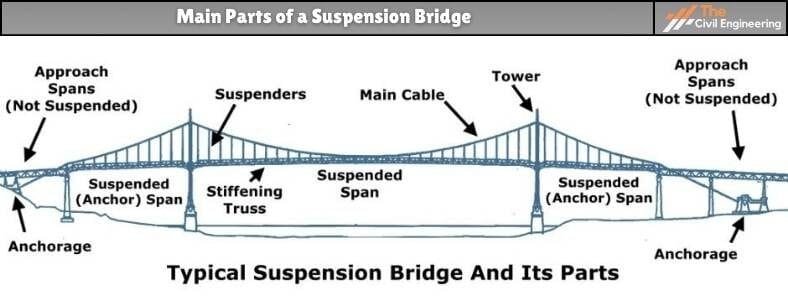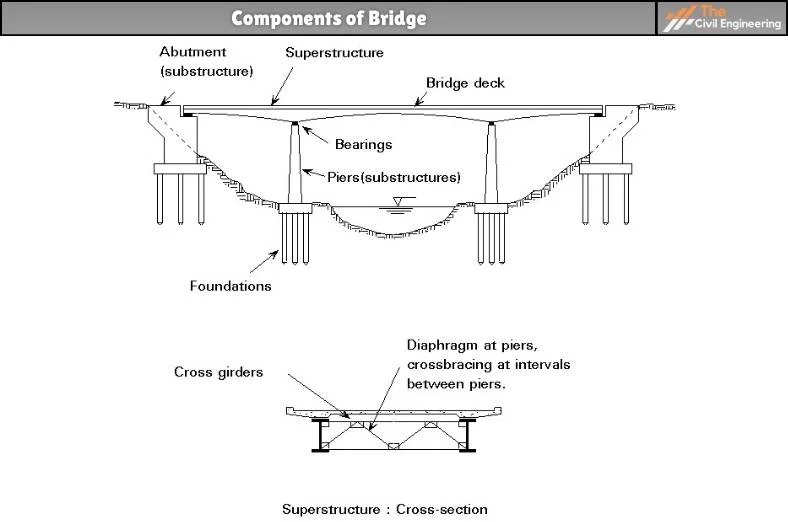The bridge is a structure that spreads horizontally between two or more supports, whose work is to carry vertical loads.
1. Parts of Bridge
The parts of the bridge structure generally contain:
a. Superstructure or decking part
b. Bearings
c. Substructure parts
a. Superstructure
i. Superstructure
The superstructure of the bridge structure contains a deck slab, girder, truss, etc. These parts vary depending on the type of bridge (whether concrete or steel or composite). The superstructure of the bridge takes the load passing/moving over it. This supports transmitting the forces given by the loads to the below substructures.
ii. Decks
The decking may be defined as the road or the rail surface of the bridge. The decks are held by the girders or the huge beams that are in turn held by the piers. The full-bridge arrangement is held with a deep foundation majorly piles and cap arrangements.
b. Bearings in Bridges
The loads taken by the decks are properly and safely passed to the substructure with the support of bearings. These are parts of the bridge that authorize even distribution of load on the substructure material.
This transmission is very important in situations where the substructure is not calculated to bear the load action directly.
The bearings provided in the bridges permit the longitudinal movement of the girders. This movement is acted due to the forces given in the longitudinal direction.
The forces due to the moving loads and the temperature difference are the major causes of longitudinal forces. The selection of bearing is dependent on different parameters, which are:
Loads applied, geometry, the range of maintenance, the permission available, the displacement, rotation, and deflection policy, availability, preference of the designer, the construction tolerances, and the cost limitation.
For the bridge design, all the factors/aspects are taken for the design and the selection of bearings. The designer must take the bearing arrangement in the bridge construction as a different system.
In most construction, the bearing is chosen or the decision for the bearing is made at the last. This results in a rise in maintenance in the upcoming months, which must be neglected.
| Read More: Girder Bridge |
c. Substructure Components of Bridges
The parts utilized in the substructure of bridges are:
a. Piers
b. Abutments
c. Wing Walls and the Returns
d. Foundation
i. Piers
The piers may be defined as the vertical structures utilized to hold the deck or the bearings are given for load transmission to underground soil through the foundation.
These structures act as support for the bridge lengths at midpoints.
The pier structure has two important works:
a. The load transmission to the Foundation of the bridge.
b. They withstand horizontal forces.
In most cases, piers are made to withstand the vertical loads alone. In areas, where there is a high chance of an earthquake, it is adopted to calculate the pier for lateral loads also.
Many piers are built using concrete. Steel for the preparation of the pier is utilized in very few cases. The utilization of composite columns i.e. steel columns filled with concrete is utilized as the advanced technology of pier construction.
The pier is a vertical member that withstands the forces byways of a shear mechanism. These forces are generally lateral. The pier that has various columns is called bent.
ii. Abutments
Abutments may be defined as vertical structures utilized to retain the earth behind the structure. The dead and the live loads transmitted from the bridge superstructure are supported by the bridge abutments.
The abutments are also put through lateral pressures mostly from the approach embankment. The design loads on the abutment are mainly dependent on the:
a. Type of abutment selected
b. The sequence of construction
iii. Wing Walls and Returns
The structures build as an extension of the abutments to hold the earth present in the approach bank are called wing walls. This part will otherwise contain a natural angle of repose. These are retaining walls build close to the abutments.
This wall can be built either connecting or independently of the abutment wall. The rear of the wall must take three design loads while designing and constructing.
This contains:
a. The earth pressure from the backfill.
b. The surcharge from the live loads or the compacting plant.
c. The hydraulic loads from the saturated soil conditions.
The stability of the wing wall is majorly dependent on its resistance against active earth pressures. The structural parts of the bridges are designed and built to stand the earth’s pressures at rest.
iv. Foundation of Bridges
Foundations are structures constructed to transmit the load from the piers, abutments, wing walls, and the returns evenly on the strata.
The foundation made for bridge structures is deep in enough manner to avoid scouring due to the water movement or to decrease the chances of undermining.
3. Parts of a Truss Bridge
The parts/components of a truss bridge are as follows:

1. Top chord/Rail
2. Bottom lateral bracing
3. Floor beam
4. Hip vertical
5. End post
6. Bottom chord
7. Deck
8. End floor beam
9. Strut
10. Portal strut
11. Diagonal
12. Vertical
4. Main Parts of a Suspension Bridge
The main parts of a suspension bridge are as follows:

1. Anchor
2. Deck/Roadway
3. Towers
4. Tower foundations
5. Suspender cables
6. Main Cable
This was for the parts of bridge.
5. References1. Content Filter & Authenticity Checking Team, The Civil Engineering (Our team checks every content & detail to maintain quality.) |
| Read More: Girder Bridge |
| Read More: Suspension bridge |

